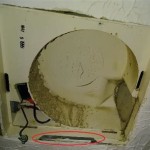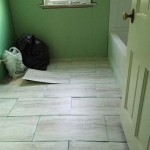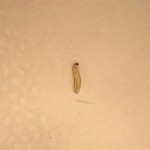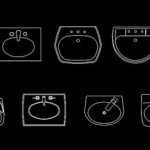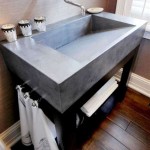Why Does My Bathroom Sink Have a Sewer Smell?
The persistent presence of a sewer smell emanating from a bathroom sink constitutes an unpleasant and often concerning household problem. The source of this foul odor is typically traced to the presence of sewer gases, which are byproducts of decomposing organic matter within the drainage system. These gases, comprised of substances like methane, hydrogen sulfide, and ammonia, pose not only an olfactory nuisance but also potential health risks at elevated concentrations. Understanding the underlying causes of sewer gas intrusion into the bathroom sink is crucial for effective identification and remediation of the issue.
Several factors can contribute to the development of a sewer smell in the bathroom sink. These factors often relate to issues within the plumbing system that compromise the intended barriers designed to prevent sewer gas from entering the living space. Identifying the specific cause requires a systematic approach, involving careful observation and, in some cases, professional plumbing expertise.
The Dry P-Trap: A Common Culprit
The P-trap, a U-shaped pipe installed beneath the bathroom sink, is designed to hold water, creating a seal that prevents sewer gases from rising up through the drain and into the bathroom. This water-filled trap acts as a physical barrier, effectively blocking the passage of gases from the sewer line. When the P-trap loses its water seal, the sewer gases can freely enter the bathroom, resulting in the characteristic foul odor.
The primary cause of a dry P-trap is infrequent use of the sink. In guest bathrooms or rarely used sinks, the water in the P-trap can evaporate over time, especially in arid climates. This evaporation breaks the water seal, allowing sewer gases to escape. Another potential cause is a slow leak in the P-trap itself. Even a small leak can gradually deplete the water level, eventually compromising the seal. Additionally, siphoning can occur when a strong vacuum is created in the drain line due to the simultaneous draining of a large volume of water from another fixture, such as a toilet or washing machine. This vacuum can pull the water out of the P-trap, leaving it dry.
Addressing a dry P-trap is typically straightforward. Simply running water into the sink for a minute or two can replenish the water level and re-establish the seal. However, if the problem persists, it indicates that another issue, such as a leak or siphoning, is causing the P-trap to empty repeatedly. In such cases, further investigation is necessary to identify and rectify the underlying cause.
Ventilation Issues: Impaired Airflow
The plumbing system incorporates a network of vent pipes that extend from the drain lines to the roof of the building. These vents serve a crucial function: to equalize air pressure within the plumbing system. This equalization prevents the formation of vacuums that can siphon water from the P-traps and allows wastewater to flow freely towards the sewer line. A properly functioning vent system ensures that air pressure is balanced throughout the plumbing system, preventing sewer gases from being forced back into the building.
When the vent system becomes obstructed, the airflow is restricted, disrupting the pressure balance. This obstruction can occur due to various factors, including bird nests, leaves, debris, or even ice accumulation during cold weather. When the vents are blocked, the negative pressure created within the drain lines can pull water out of the P-traps, leading to the release of sewer gases into the bathroom.
Identifying a blocked vent can be challenging, especially if the blockage is located high up on the roof. Signs of a ventilation problem may include gurgling sounds coming from the drains, slow draining sinks or toilets, and the persistent presence of sewer smells. A visual inspection of the vent openings on the roof may reveal obvious obstructions. In some cases, a plumber may need to use specialized equipment, such as a plumbing snake or camera, to locate and remove the blockage.
Maintaining a clear and unobstructed vent system is essential for preventing sewer gas problems. Regular inspections of the vent openings are recommended, especially in areas prone to debris accumulation. If a blockage is suspected, professional assistance is often required to ensure safe and effective removal of the obstruction.
Sewer Line Problems: A More Serious Concern
The sewer line is the main drainpipe that carries wastewater from the building to the municipal sewer system or a septic tank. Damage or blockages within the sewer line can create significant plumbing problems, including the backflow of sewer gases into the building. While less common than dry P-traps or ventilation issues, sewer line problems represent a more serious concern due to the potential for widespread plumbing malfunctions and unsanitary conditions.
Cracks or breaks in the sewer line can allow sewer gases to escape into the surrounding soil. These gases can then migrate through the ground and enter the building through cracks in the foundation or around plumbing fixtures. Tree root infiltration is a common cause of sewer line damage, as roots seek out moisture and nutrients within the pipe. Over time, these roots can expand and crack the pipe, creating openings for sewer gas leaks. Additionally, the accumulation of grease, debris, or foreign objects can cause blockages in the sewer line. These blockages can create pressure buildup, forcing sewer gases back into the building through the drain lines.
Signs of a sewer line problem may include multiple drains backing up simultaneously, sewage smells originating from multiple locations within the building, and slow-draining sinks and toilets. A professional plumber can use a camera inspection to assess the condition of the sewer line and identify any cracks, breaks, or blockages. Depending on the severity of the problem, repairs may involve patching the pipe, replacing a section of the pipe, or using trenchless technology to reline the pipe.
Addressing sewer line problems requires professional expertise and specialized equipment. Attempting to repair a sewer line without the necessary knowledge and tools can be dangerous and may result in further damage. Regular maintenance, such as avoiding the disposal of grease down the drain, can help prevent sewer line blockages and prolong the lifespan of the system.
Biofilm Buildup: An Often Overlooked Factor
Biofilm, a slimy layer of microorganisms that adheres to surfaces in moist environments, can accumulate within the drainpipes of the bathroom sink. This biofilm is composed of bacteria, fungi, and other microorganisms that feed on organic matter present in the wastewater. As these microorganisms decompose organic materials, they produce gases, including sulfur compounds, which contribute to the characteristic sewer smell.
The warm, moist environment within the drainpipes provides an ideal breeding ground for biofilm. Soap scum, hair, food particles, and other debris can become trapped within the drain, providing a constant source of nutrients for the microorganisms. Over time, the biofilm can thicken and spread, increasing the production of foul-smelling gases.
While not as directly related to plumbing malfunctions as dry P-traps or ventilation issues, biofilm buildup can significantly contribute to the presence of sewer smells in the bathroom. Regularly cleaning the drain with a drain cleaner or a mixture of baking soda and vinegar can help to remove the biofilm and reduce the odor. Pouring boiling water down the drain can also help to dislodge biofilm and kill the microorganisms. In severe cases, a plumber may need to use specialized equipment, such as a drain snake or hydro jet, to thoroughly clean the drainpipes.
Preventing biofilm buildup involves minimizing the amount of organic matter that enters the drain. Using a drain strainer to catch hair and debris, avoiding the disposal of grease down the drain, and periodically flushing the drain with hot water can help to keep the drainpipes clean and prevent the formation of biofilm.
Loose or Damaged Plumbing Connections
Sewer gases can escape through loose or damaged plumbing connections around the bathroom sink. This includes connections to the drainpipe, the P-trap, and the faucet. Over time, these connections can loosen due to vibration, corrosion, or improper installation. Cracks or leaks in these connections can create openings for sewer gases to escape, resulting in an unpleasant odor in the bathroom.
Inspecting the plumbing connections beneath the sink for any signs of leaks or damage is crucial. Check the connections around the P-trap, the drainpipe, and the faucet. Look for water stains, corrosion, or cracks in the pipes or fittings. If any loose connections are found, tighten them with a wrench. If any damaged pipes or fittings are observed, they should be replaced by a qualified plumber.
Properly sealing plumbing connections is essential for preventing sewer gas leaks. Plumbers often use plumber's putty or Teflon tape to create a watertight seal between pipes and fittings. Ensure that all connections are properly sealed during installation or repair. Regularly inspecting the plumbing connections and addressing any leaks or damage promptly can help to prevent sewer gas problems in the bathroom.
Addressing a sewer smell emanating from a bathroom sink necessitates a systematic approach. Starting with the most common and easily rectifiable causes, such as a dry P-trap, and progressing to more complex issues like ventilation problems or sewer line damage, is the recommended procedure. In cases where the source of the odor remains elusive or the problem persists despite initial efforts, seeking professional plumbing assistance is advised. A qualified plumber possesses the expertise and equipment to accurately diagnose the root cause of the issue and implement the appropriate solution, ensuring a healthy and odor-free bathroom environment.

How To Clean A Stinky Sink Drain Home Repair Tutor

What Causes Bathroom Drains To Smell

Sewer Smell In Bathroom Identify And Eliminate The Odor

How To Get Rid Of The Sewer Smell From A Bathroom Terry S Plumbing

Sewer Smell In Bathroom Solved Bob Vila

My Bathroom Smells Like A Sewer What Causes That And How Do You Fix It Kitchen Infinity

7 Causes Of A Sewer Smell In The Bathroom Hays

Bathroom Smells Like Sewage Causes Fixes Inside Out

Why Does My Bathroom Smell Like Sewage 9 Tips For A Happy Home Phyxter Services

Why Is There A Sewer Odor In My Bathroom Ben Franklin Bay Area

